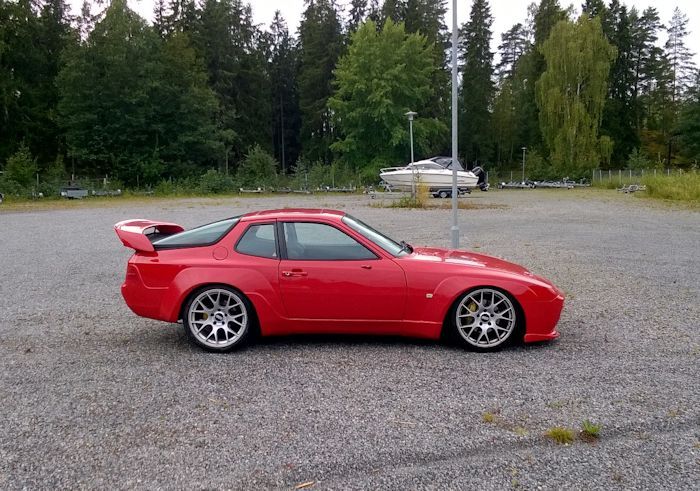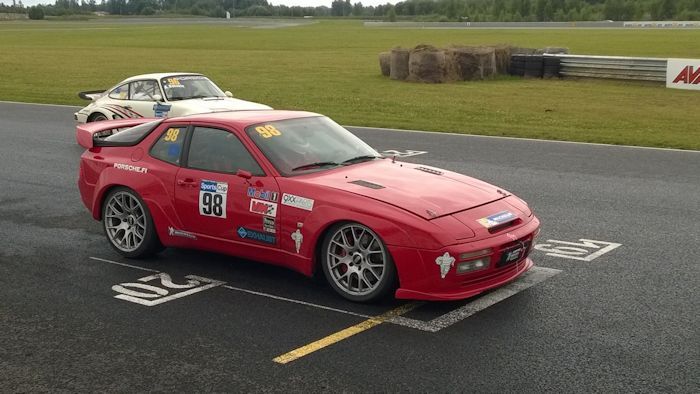LINDSEY RACING CYLINDER HEADS This is not your average cylinder head. Lindsey Racing heads are professionally machined and ported to perfection and then flow tested to prove it, each and every head, guaranteed! If you want the best, you found it. One of the last items that most people address in an engine upgrade is the cylinder head. They focus on other areas like Turbo Chargers, Mass Air Flow systems, camshafts, throttle bodies, exhaust systems, etc. All of these upgrades are well and good, but the limiting factor in any equation is still the smallest or most restrictive orifice that limits the engines overall ability to flow air into it. The last remaining item in this long chain of events that occurs in the engine is the cylinder head. Despite all the other mods, eventually the air is going to have to squeeze through the port on it's way into the cylinder. Airflow through the cylinder head is the biggest single variable in engine performance. Huge gains in performance can be obtained by precise head work. Some engine builders rely on intuition when it comes to port shape on engines. Flow bench testing while porting will show you that intuition is often a very poor guide. Many "improvements" they make can actually reduce the flow. If every port and valve is not checked and optimized on the flow bench, there is no way to guarantee the engine will be a top performer. Lindsey Racing cylinder heads are top performers. We guarantee our advertised flow numbers on all cylinder heads. Some companies claiming porting and polishing will not. Ever wonder why? Another FIRST from Lindsey Racing. In our never-ending quest to perfect an already good thing, we have managed to make another break through not available anywhere else. Have you heard about port velocities? In recent years, factory engineers as well as high performance engine builders have started to look at not just the CFM that a head flows but also the speed at which the air is traveling. This is evident in the number of factory cars now being offered with 4 valve cylinder heads. Not only do they flow greater numbers but the port velocities are much higher as well. Our "Flow Guy" has the latest in flow bench technology which incorporates computerized sensors that measure the velocity at which the air is passing through the port. For an intake port to work efficiently port speeds need to be in the 350 FPS range. The ported heads we offer at Lindsey Racing are right in that ideal range. The exhaust port is a different story. A good exhaust port design should flow in the 600 FPS range. The stock configuration of the 944 Turbo is well shy of this, in fact it is less than 400 FPS. One option that some shops have tried is to take the 944 NA head and port and polish it on both intake and exhaust ports. The correct porting of the exhaust can increase the velocity as well as the flow. This is all well and good, but what is missing is the ceramic port liner that Porsche built into the Turbo head. We felt that it would be beneficial to retain the ceramic liner if possible so Lindsey Racing has been testing different combinations on the 951 head to try and increase the port velocity without significant loss to the flow numbers. The problem is that the ceramic liner that is inside the exhaust port on the Turbo head cannot be altered, so porting the exhaust cannot be done. There is an alternative and we have discovered what that is. We now have found a combination that the exhaust flows 185 CFM with the velocity increased from a miserable 390 to an impressive 566 FPS! That is a 45% increase in velocity with only a 3% loss in flow rate! Imagine what will happen to the Turbo when you hit it with hot exhaust gases that are moving so much faster. You guessed it, quicker spooling and increased HP. You expect more from Lindsey and you get it! This very affordable option is available on all 2 valve heads from Lindsey Racing. If you haven't already visited the section of this web-sight about our Intake Manifold, you need to do so. The significant gains we achieve in our cylinder head cannot be fully realized without combining it with our new Intake. The combination of these two components can make your car perform like no other. No longer will the horsepower "fall off" early. Feel the power as your engine now pulls hard all the way to red line. The head is first disassembled and cleaned with a close inspection to make sure that the head is a good candidate for the upgrade work. One major problem that is noticed on about one in five heads is the ceramic liner in the exhaust port has begun to break up. This is a serious problem. Debris breaking off from the liner could damage the Turbo, and regrettably means the head is not worth going any further. 
If everything looks good, the valve guides are then replaced. The next step is the valve job. Valve seats on Lindsey Racing heads are NOT stone cut! The valve job is done on specialized equipment. A precision 5-angle cutter is used which makes all the seats exactly the same size. You can also control the seat depth from cylinder to cylinder. The valve job must be performed before the porting process can begin. A clean up cut of the deck surface to assure a good seal on the head gasket is next. Then, if porting is desired, it's onto the port shop to visit the "Flow Guy".  Our "Flow Guy" has, for almost 40 years, been in the business of flowing cylinder heads and intake manifolds primarily in the drag racing industry. He uses a Super Flow SF600 flow bench for measuring the air flow within the port. His skill and understanding of what makes air do things inside a port was quickly recognized by us. We began working closely with him flow testing on the cylinder head as well as many other components in the air intake system. Above you see a 951 head mounted on the flow bench. The valve is installed and opened to equal the lift of the camshaft with a dial indicator. This insures the advertised flow number with the stock lift. Higher lift cams will net higher flow numbers. Click on pictures below to take a close look at the workmanship on these 951 heads.
Back at the machine shop now. The next stage is the optional o-ring groove. This operation is performed on a Vertical mill. A final cleaning is done before assembly begins. Springs are measured and installation height is precisely set. Most heads are assembled with our Racing Springs or new factory springs. Care must be taken when deciding on valve train components. Larger valves require higher spring pressures to close that heavier valve. 
We currently have 6 levels of 944 and 951 heads. From Mild to Wild. Completely assembled and ready for installation. We can flow 928 and 911 heads as well. Level I 8v
Level II 8v
Level III 8v
Level IV 8v
Level V 8v
Level V+ 8v

Flow measurements taken of the intake port of a stock head (at the .480" lift of the camshaft) flows 180 CFM at 28 inches of vacuum (water column). The exhaust port on the other hand, flows 191 CFM at the same lift only with a significantly smaller valve. It's all in the shape of the port. There have been numerous studies performed regarding how much air the exhaust port needs to flow in relationship to the intake port. Most competent porting services around the country say that as long as the exhaust flows around 80% of the intake that is good! Super Flow (flow bench manufacturer) claims that their testing has shown that no noticeable gains were found as long as the exhaust was 60% of the intakes flow. Porsche designed an excellent exhaust port in the 951. The port is actually a ceramic tube, which the head is cast around. The surface of the port is already smooth and with its stock flow numbers of 191 CFM, the need to modify it is unnecessary. The intake port on the other hand is aluminum and this one leaves a lot to be desired. His first attempt netted an increase from 186 (a 6 CFM increase was gained from 5 angle valve job) to the 229-CFM, with more experience he has increased this to 232-CFM. This is a 28.8% improvement, which is significant. If you calculate the intake flow of 232-CFM to the stock exhaust flow of 191-CFM, you will see that the ratio is around 80%. Well within the desired range. These flow numbers were achieved with stock valves. We are currently experimenting with larger valves and other mods to the intake port but for most applications the need for larger valves is not necessary. Higher lift cams will net higher flow figures. With the addition of a slightly larger intake valve with a different stem design, we up the CFM to 252CFM which we call our Level III head. This is a perfect match for our new High Flow Intake manifold. We can O-ring heads for your 2.5L, 2.8L or 3.0L applications utilizing the 951 block. Building a 3.0L using a 968 block and wanting to use a 951 8 valve head? Lindsey Racing can take care of the water passage alteration necessary to join the two. Relocating the water jacket to mate to the 968 block. Top View. Bottom View.
When shopping for your next cylinder head upgrade, insist on the numbers. After all, that is what you're paying for with a port and polish. Anything less is just a valve job. We hear the claims by other companies and wonder why they don't advertise flow numbers. We welcome the chance to test them and see if they stand up to ours. If you have a head, from someone else, we will flow it for you free of charge. We recently tested a Powerhaus Ported and Polished cylinder head from a customer's race car. After cleaning it up, it flowed 216 CFM at 28" with .480 lift. Not bad, but our stock valved head flows 7% more air with our Port and Polish. There is a difference so insist on the numbers. This customer's head is now getting re-ported by us, getting our big valve and high velocity work. He is spending $2,300 to have his "Ported and Polished Powerhaus Race Head" worked by us. Don't spend the money twice. Do it right and all the way the first time with Lindsey Racing. Besides, you can't get the "high velocity" exhaust work anywhere else. Our competition is probably scratching their heads, wondering what we did to achieve this. It wasn't easy so we don't expect any followers any time soon. |
Secure Checkout










